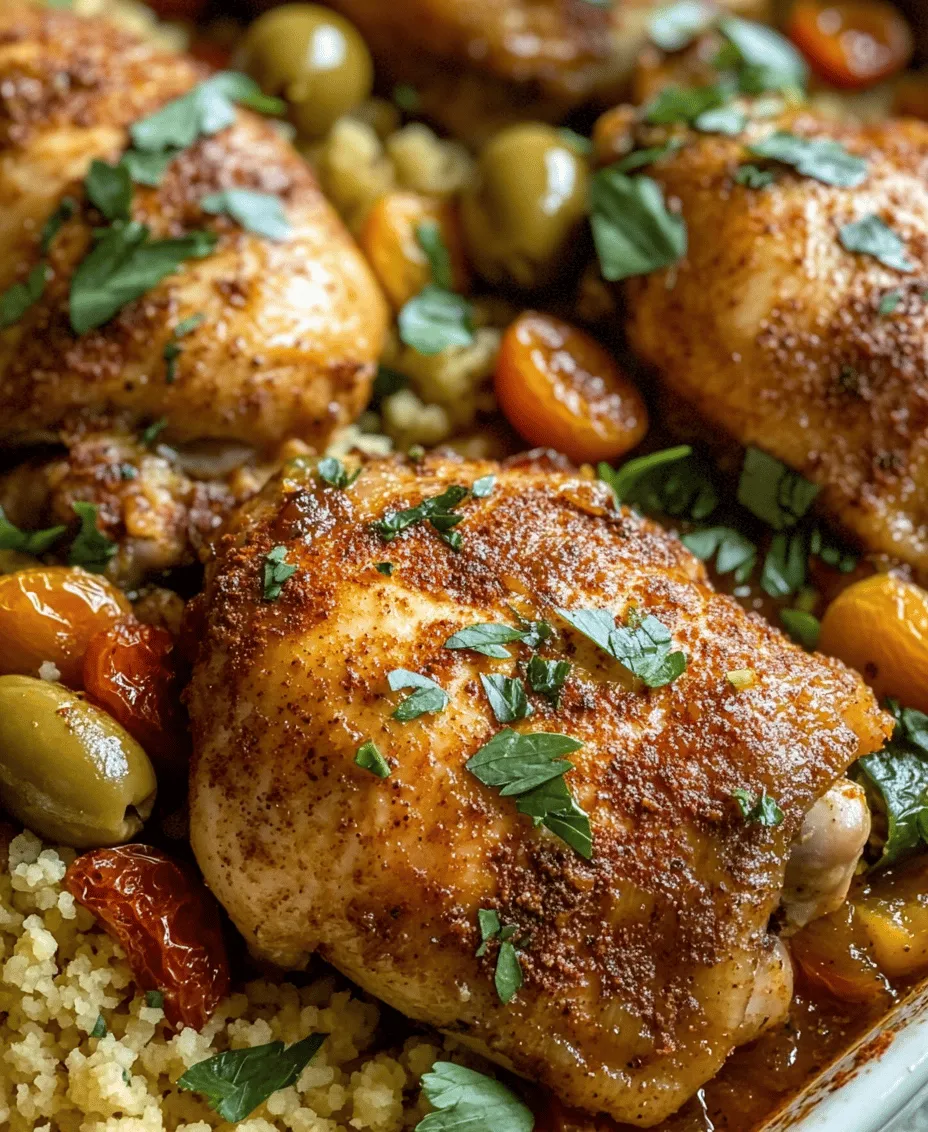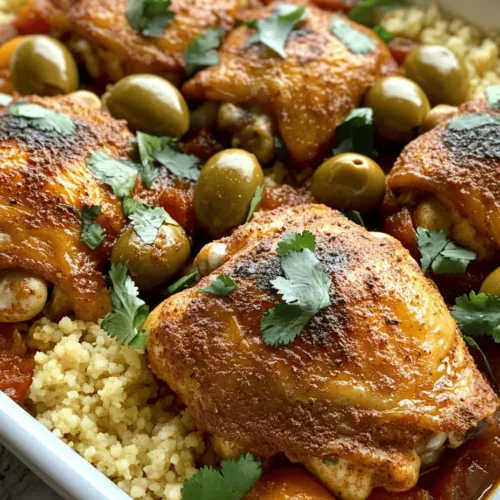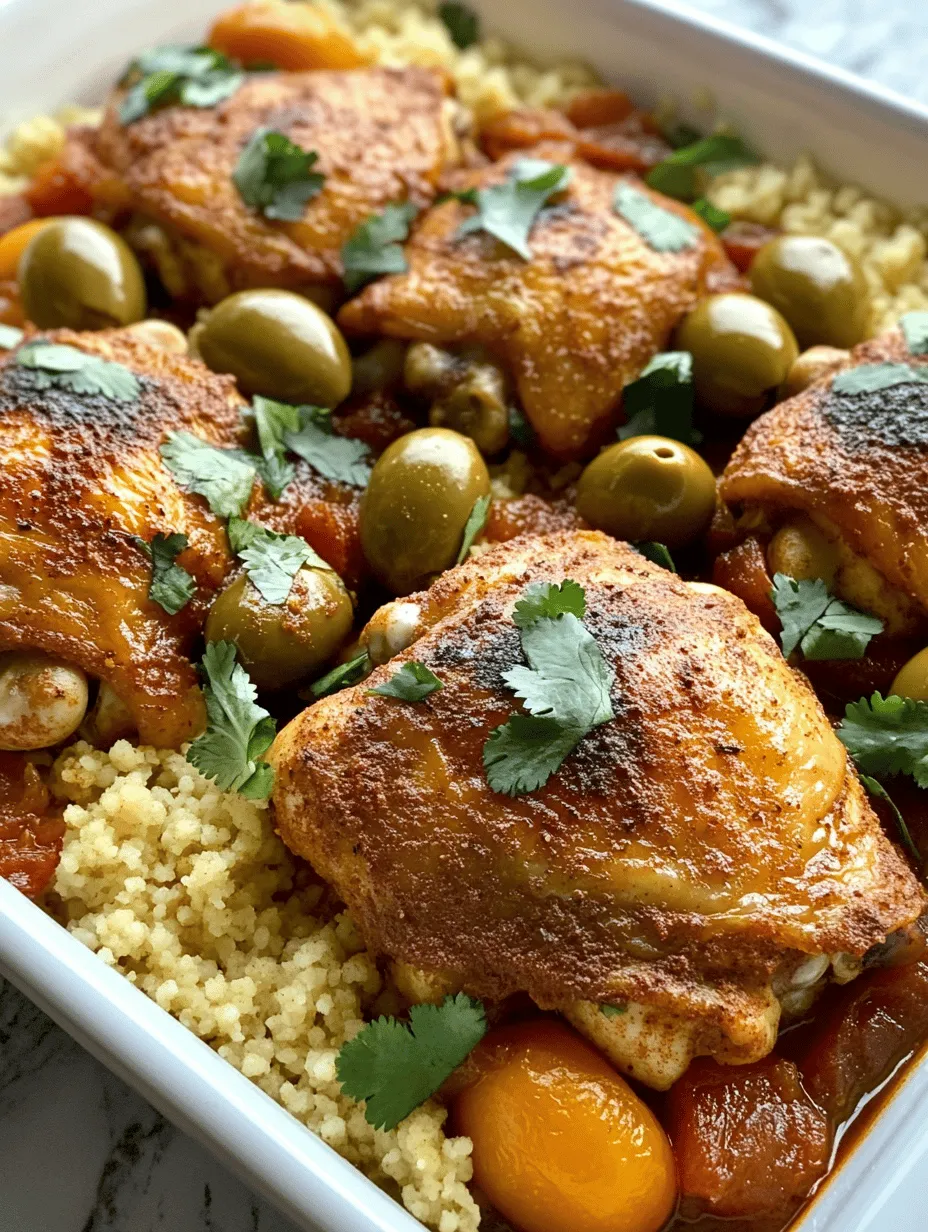Introduction
Moroccan cuisine is a vibrant tapestry of flavors, aromas, and textures, influenced by the diverse cultures that have inhabited the region over centuries. From the bustling souks of Marrakech to the coastal towns of Essaouira, Moroccan food reflects a rich history of trade and agriculture, combining Berber, Arabic, and Mediterranean culinary traditions. The use of spices is central to Moroccan cooking, transforming simple ingredients into extraordinary dishes that tantalize the taste buds.
At the heart of this culinary heritage is the Moroccan Spiced Chicken, a dish that encapsulates the essence of the country’s cuisine. This recipe features tender chicken thighs marinated in a fragrant blend of spices, simmered with fresh vegetables, and accented with the sweetness of dried fruits and the brininess of olives. Not only is Moroccan Spiced Chicken delicious, but it also holds cultural significance within Moroccan households, often served during gatherings and celebrations. The dish’s complex flavor profile and beautiful presentation make it a favorite among both novice cooks and seasoned chefs.
The key to unlocking the rich flavors of Moroccan Spiced Chicken lies in the careful selection and use of spices. Cumin, coriander, cinnamon, paprika, ginger, and cayenne pepper come together to create a harmonious spice blend that elevates the chicken and enhances the overall taste of the dish. Not only do these spices add depth and warmth, but they also offer various health benefits, making this dish a wholesome choice for any meal.
Understanding the Ingredients
The Role of Chicken Thighs in Moroccan Cooking
When it comes to Moroccan Spiced Chicken, the choice of chicken thighs is intentional. Thighs are favored over breasts for their richer flavor and moist texture, making them ideal for slow cooking. They absorb the spices beautifully, resulting in a dish that is both succulent and full of flavor. Additionally, chicken thighs are more forgiving when it comes to cooking time, ensuring that you achieve a tender result without the risk of drying out.
Health Benefits of Using Olive Oil
Olive oil is a staple in Moroccan cooking, valued not only for its flavor but also for its health benefits. Rich in monounsaturated fats, olive oil can support heart health and reduce inflammation. It also adds a depth of flavor to the dish and serves as a base for sautéing the aromatics. When preparing Moroccan Spiced Chicken, using high-quality extra virgin olive oil will enhance the overall taste and provide essential nutrients.
The Impact of Fresh Vegetables: Onions and Garlic
Fresh ingredients are essential for achieving the best flavors in any dish, and Moroccan Spiced Chicken is no exception. Onions and garlic form the aromatic foundation of this recipe. When sautéed, they release their natural sweetness and fragrance, creating a delicious base for the spices and chicken. Onions provide a subtle depth, while garlic adds a pungent kick, balancing the richness of the chicken and olive oil.
Exploring the Spice Blend
The spice blend in Moroccan Spiced Chicken is what truly sets this dish apart. The combination of cumin, coriander, cinnamon, paprika, ginger, and cayenne pepper creates a warm, aromatic profile that is unmistakably Moroccan. Each spice plays a crucial role:
– Cumin: Earthy and nutty, cumin adds depth and warmth.
– Coriander: With its citrusy notes, coriander brightens the dish.
– Cinnamon: Sweet and fragrant, cinnamon introduces a touch of warmth.
– Paprika: Adds color and a mild sweetness, enriching the overall flavor.
– Ginger: Provides a spicy kick and enhances digestion.
– Cayenne: Offers a bit of heat, allowing you to adjust the spice level to your preference.
Together, these spices create a complex flavor profile that is both comforting and exotic, capturing the essence of Moroccan cuisine.
The Significance of Canned Tomatoes and Chicken Broth
To create a rich sauce that envelops the chicken and vegetables, canned tomatoes and chicken broth are essential components. Canned tomatoes provide a convenient way to add acidity and sweetness, while chicken broth enhances the overall flavor. The combination of these ingredients results in a sauce that is both savory and slightly tangy, perfectly complementing the spices and chicken. When simmered together, they create a cohesive dish, allowing the flavors to meld beautifully.
The Addition of Green Olives and Dried Apricots
For a remarkable taste and texture balance, green olives and dried apricots are quintessential additions to Moroccan Spiced Chicken. The briny flavor of the olives contrasts wonderfully with the sweetness of the apricots, creating an exciting interplay of flavors. The olives add a salty note that enhances the dish’s savory elements, while the apricots introduce a hint of sweetness, making each bite a delightful experience.
Choosing the Right Garnish: Fresh Cilantro
Garnishing your Moroccan Spiced Chicken with fresh cilantro not only adds a pop of color but also introduces a burst of freshness that brightens the dish. The herb’s citrusy notes complement the spices and create a well-rounded flavor profile. When serving, consider sprinkling a handful of chopped cilantro over the finished dish for an added touch of vibrancy.
Serving Options: Couscous or Rice as Traditional Accompaniments
When it comes to serving Moroccan Spiced Chicken, traditional accompaniments such as couscous or rice are excellent choices. Couscous, a staple in Moroccan cuisine, is light and fluffy, providing a perfect base for soaking up the rich sauce. Alternatively, fluffy rice serves as a neutral canvas that allows the flavors of the chicken to shine. Both options are versatile and easy to prepare, making them ideal companions for this flavorful dish.
Preparation Steps for Moroccan Spiced Chicken
Importance of Using a Heavy-Bottomed Skillet or Dutch Oven
To achieve the best results when preparing Moroccan Spiced Chicken, it is essential to use a heavy-bottomed skillet or Dutch oven. These cooking vessels distribute heat evenly, ensuring that the chicken cooks uniformly and the spices bloom effectively. The added weight helps to prevent scorching, allowing for a gentle simmer that enhances the flavors of the dish.
Detailed Walkthrough of Each Cooking Step
Now that you understand the key ingredients and their roles, let’s dive into the preparation steps for creating your Moroccan Spiced Chicken.
1. Prepare the Chicken: Start by patting the chicken thighs dry with paper towels. This step is crucial for achieving a golden-brown crust during the searing process. Once dried, season the chicken generously with salt and freshly ground black pepper.
2. Create the Spice Mix: In a small bowl, combine the spices: cumin, coriander, cinnamon, paprika, ginger, and cayenne pepper. This spice mix will be the cornerstone of your dish, so ensure it is well combined for an even distribution of flavors.
3. Sauté the Onions and Garlic: Heat a few tablespoons of olive oil in your heavy-bottomed skillet or Dutch oven over medium heat. Once the oil is shimmering, add the chopped onions and sauté for about 5-7 minutes, or until they become translucent and slightly caramelized. Next, add minced garlic and sauté for an additional minute, stirring frequently to avoid burning.
4. Sear the Chicken Thighs: Increase the heat to medium-high and add the seasoned chicken thighs to the skillet. Allow them to sear for about 4-5 minutes per side, or until they develop a deep golden-brown crust. This step is crucial for locking in the moisture and flavor.
5. Combine Ingredients: Once the chicken is seared, sprinkle the spice mix over the chicken and stir to coat evenly. Add the canned tomatoes, chicken broth, green olives, and dried apricots to the skillet. Stir everything together, ensuring that the chicken is submerged in the flavorful sauce.
6. Simmer the Dish: Bring the mixture to a gentle simmer, then reduce the heat to low. Cover the skillet or Dutch oven and let it cook for about 30-40 minutes. This slow cooking process allows the flavors to meld and the chicken to become tender and juicy.
Through each step, you’ll be engaging with the vibrant aromas and colors that define Moroccan Spiced Chicken, setting the stage for a dish that is not only a feast for the palate but also a celebration of culinary tradition. The combination of spices, fresh ingredients, and careful preparation will result in a dish that is sure to impress both family and guests alike.

Simmering Techniques: Ensuring Tender, Flavorful Chicken
To achieve the ultimate tenderness in your Moroccan Spiced Chicken, mastering the simmering process is crucial. After browning your chicken pieces to create a flavorful crust, you’ll want to reduce the heat to a low simmer. This gentle cooking method allows the chicken to cook evenly, ensuring that the meat remains juicy and tender. Ideally, the chicken should simmer in the aromatic spice mixture for about 30-40 minutes, depending on the size of the pieces.
During this simmering phase, it’s important to cover the pot with a tight-fitting lid. This traps steam and moisture, preventing the chicken from drying out while still allowing the spices to permeate the meat fully. You can also add a splash of chicken broth or water if you notice the sauce thickening too much. The goal is to maintain a balance where the sauce is rich and concentrated without becoming overly dry.
Final Touches: Incorporating Olives and Apricots
Once your chicken is tender and infused with flavor, it’s time to incorporate the finishing touches that elevate this dish. Adding olives and dried apricots not only enhances the flavor profile but also contributes to the dish’s authentic Moroccan essence.
For this step, use pitted green olives and chopped dried apricots. Stir them into the simmering pot during the last 10 minutes of cooking. The olives bring a briny, savory note that contrasts beautifully with the sweetness of the apricots. As the fruit heats through, it will soften and infuse the sauce with a subtle sweetness, creating a harmonious balance of flavors. This combination is a hallmark of Moroccan cuisine, where sweet and savory elements coexist in delightful synergy.
Flavor Profile and Texture
Analyzing the Complexity of Flavors: Sweet, Savory, and Spicy
Moroccan Spiced Chicken is renowned for its intricate blend of flavors. The spices—cumin, coriander, cinnamon, and paprika—create a warm, earthy base that is both comforting and exotic. Sweet notes from the dried apricots and the aromatic warmth of cinnamon blend seamlessly with the savory undertones of olive oil and garlic. Additionally, a touch of heat can be introduced through cayenne pepper or harissa, resulting in a dish that is not only satisfying but also exciting to the palate.
The complexity of flavors is a result of the layering technique used throughout the cooking process. As each ingredient releases its essence during cooking, the dish evolves, offering a depth that is characteristic of Moroccan cuisine.
The Role of Cooking Techniques in Texture: Crispy Skin vs. Tender Meat
Texture plays a vital role in the enjoyment of Moroccan Spiced Chicken. The initial browning of the chicken skin is essential for achieving a crispy exterior that contrasts with the tender, juicy meat within. This duality of texture is not only pleasing to the mouth but also visually appealing.
As the chicken simmers, the meat becomes tender and absorbs the rich flavors of the spices. It’s important to monitor the cooking time to ensure the skin retains its crispness while the meat remains succulent. If you prefer an extra crispy finish, you can place the chicken under the broiler for a few minutes after simmering. This method enhances the texture while adding a beautiful golden hue to the dish.
How the Dish Evolves During Cooking: Layering Flavors
The cooking process for Moroccan Spiced Chicken is a beautiful example of how flavors can develop and deepen over time. Each step—from browning the chicken to simmering with spices—contributes to the final tasting experience. The initial sear creates a Maillard reaction, producing complex flavors that serve as the foundation for the dish.
As you add ingredients like onions, garlic, and spices, each component builds upon the last. The interplay of flavors continues as the chicken absorbs the sauce, resulting in a layered taste profile that is rich and inviting. This culinary evolution is what makes Moroccan Spiced Chicken a favorite in many households.
Cultural Significance of Moroccan Spiced Chicken
The Historical Context of Moroccan Cuisine
Moroccan cuisine is a rich tapestry woven from the influences of various cultures, including Berber, Arab, and Mediterranean. The use of spices and the practice of slow cooking are hallmarks of this culinary tradition, allowing for the development of deep flavors. Moroccan Spiced Chicken exemplifies these characteristics, showcasing a dish that is both a celebration of local ingredients and a reflection of the country’s diverse heritage.
The traditional use of spices in Moroccan cooking is steeped in history, as trade routes brought exotic flavors to the region. Ingredients such as saffron, cumin, and cinnamon became staples, creating a unique flavor profile that distinguishes Moroccan dishes from those of other cultures.
How Moroccan Spiced Chicken Reflects Traditional Cooking Methods
Moroccan Spiced Chicken is more than just a meal; it embodies the essence of Moroccan cooking traditions. The use of tagines, earthenware cooking vessels, is central to the preparation of many Moroccan dishes, including this one. While you can prepare it in a traditional pot, the tagine offers an exceptional way to slow-cook the chicken, allowing the spices to infuse thoroughly.
The communal aspect of Moroccan dining is also significant. Dishes like Moroccan Spiced Chicken are often served family-style, encouraging sharing and connection among diners. This not only enhances the culinary experience but also reflects the importance of hospitality in Moroccan culture.
The Dish’s Role in Family Gatherings and Celebrations
Moroccan Spiced Chicken holds a special place in family gatherings and festive occasions. It is often featured during celebrations such as weddings, Eid, and other important events, symbolizing abundance and joy. The communal nature of the dish fosters a sense of togetherness, making it a perfect centerpiece for any gathering.
As families come together to enjoy this flavorful dish, it serves as a reminder of the rich traditions and cultural heritage that define Moroccan cuisine. Sharing Moroccan Spiced Chicken is not just about nourishment; it is about creating lasting memories and celebrating life’s milestones.
Nutritional Information
Breakdown of Nutritional Content Per Serving
Understanding the nutritional profile of Moroccan Spiced Chicken can help you appreciate its health benefits. A typical serving of this dish (approximately 4 ounces of chicken with sauce) contains:
– Calories: 350
– Protein: 28g
– Carbohydrates: 15g
– Fat: 18g
– Fiber: 2g
– Sodium: 600mg
This breakdown highlights the dish’s protein-rich content, making it a satisfying meal option.
Discussing the Health Benefits of the Ingredients Used
The ingredients in Moroccan Spiced Chicken are not only flavorful but also packed with health benefits. Chicken is a great source of lean protein, essential for muscle maintenance and overall health. The spices used—such as turmeric, cumin, and coriander—are known for their anti-inflammatory properties and potential health benefits, including improved digestion and enhanced metabolism.
Olives, a key ingredient in this dish, are rich in monounsaturated fats, which are beneficial for heart health. Dried apricots provide a natural source of sweetness along with vitamins A and C, fiber, and antioxidants, making them a nutritious addition to the dish.
Highlighting Dietary Considerations: Gluten-Free, Protein-Rich, etc.
Moroccan Spiced Chicken is a versatile dish that accommodates various dietary needs. It is naturally gluten-free, making it suitable for those with gluten sensitivities. Additionally, the high protein content makes it an excellent choice for those seeking to maintain or build muscle.
For those following a low-carb diet, the dish can be enjoyed without traditional side dishes like couscous or bread. Instead, consider pairing it with a fresh salad or steamed vegetables for a complete meal that aligns with dietary preferences.
Pairing Suggestions
Recommended Side Dishes to Complement Moroccan Spiced Chicken
To create a well-rounded Moroccan-inspired meal, consider pairing your Moroccan Spiced Chicken with traditional sides. Here are some popular options:
1. Couscous: Fluffy couscous is a classic accompaniment that soaks up the rich sauce from the chicken.
2. Roasted Vegetables: A medley of seasonal vegetables, roasted with olive oil and spices, provides a colorful and nutritious addition.
3. Moroccan Salad: A refreshing salad made with tomatoes, cucumbers, and fresh herbs, dressed with lemon and olive oil, balances the richness of the chicken.
Beverage Pairings: Traditional Moroccan Drinks or Modern Options
To complement your Moroccan Spiced Chicken, consider serving it with traditional Moroccan mint tea, a sweet and refreshing beverage that pairs beautifully with the spices in the dish. For a modern twist, a light-bodied red wine or a citrus-infused sparkling water can also enhance the dining experience.
How to Create a Complete Moroccan-Inspired Meal
To create a complete Moroccan-inspired meal, start with a flavorful appetizer such as harira (Moroccan soup), followed by the Moroccan Spiced Chicken as your main course. Pair it with couscous or roasted vegetables and finish with a delightful dessert like baklava or almond pastries. This combination not only showcases the diverse flavors of Moroccan cuisine but also offers a memorable culinary experience for your guests.
Conclusion
In summary, Moroccan Spiced Chicken is a dish that captivates with its complex flavors, tender texture, and cultural significance. Rooted in Moroccan culinary traditions, this dish brings together sweet, savory, and spicy elements in a way that is both satisfying and memorable. As you explore the preparation and enjoy the rich taste of this dish, you’ll appreciate the art of Moroccan cooking and its ability to create connections through food.
I encourage you to delve deeper into Moroccan cuisine by trying out other traditional recipes. Each dish tells a story, reflecting the history, culture, and community that shape it. Moroccan Spiced Chicken is just the beginning of your culinary adventure; there are countless flavors and techniques waiting to be discovered in this vibrant cuisine.



